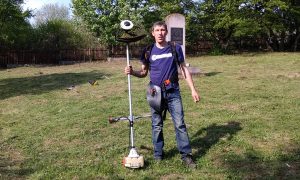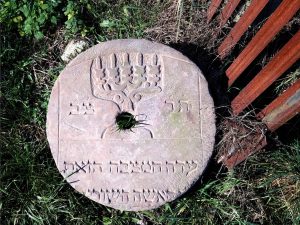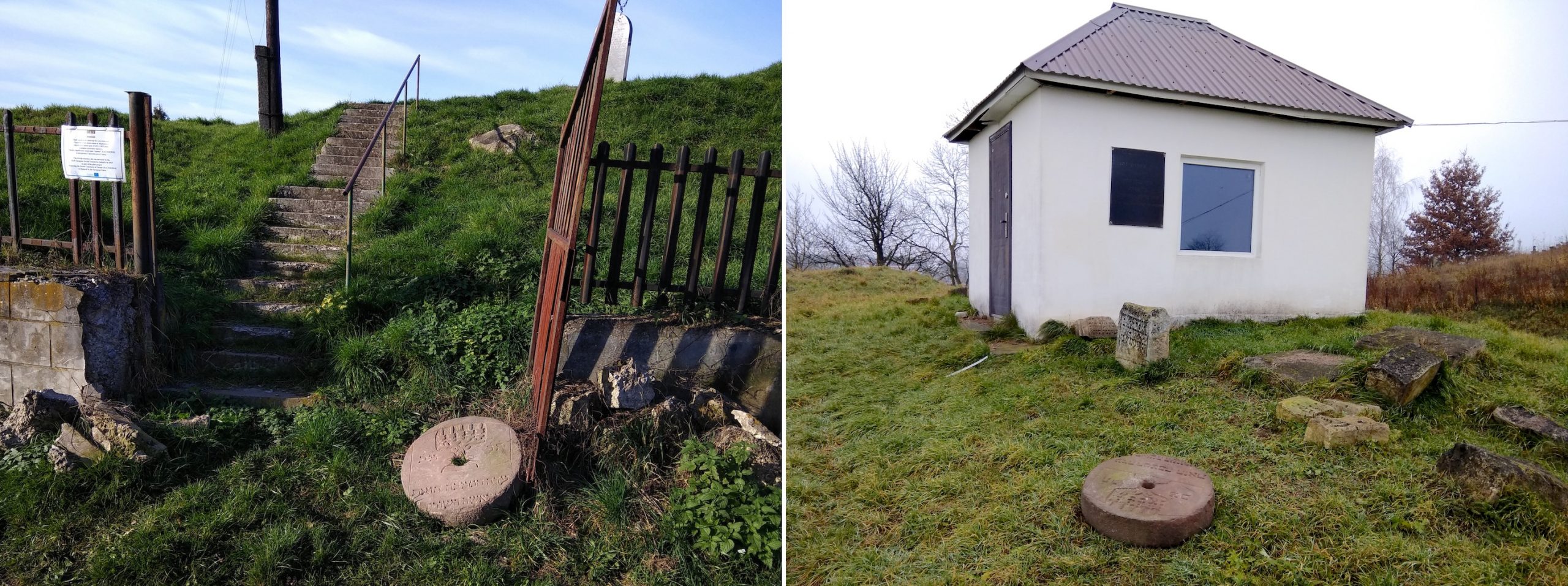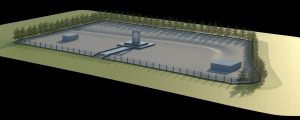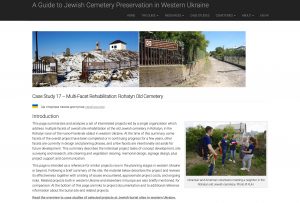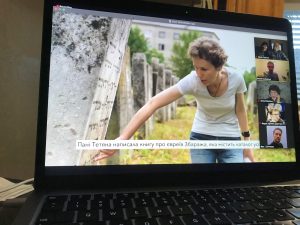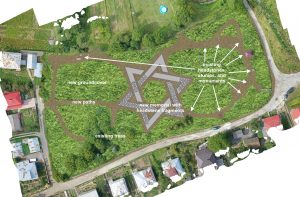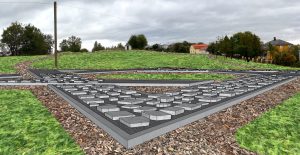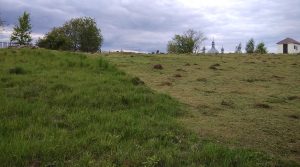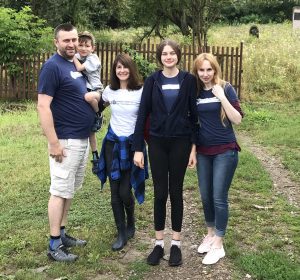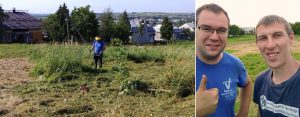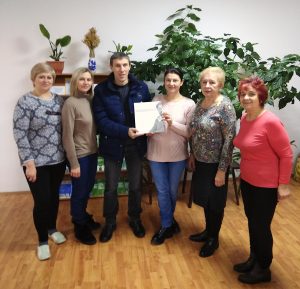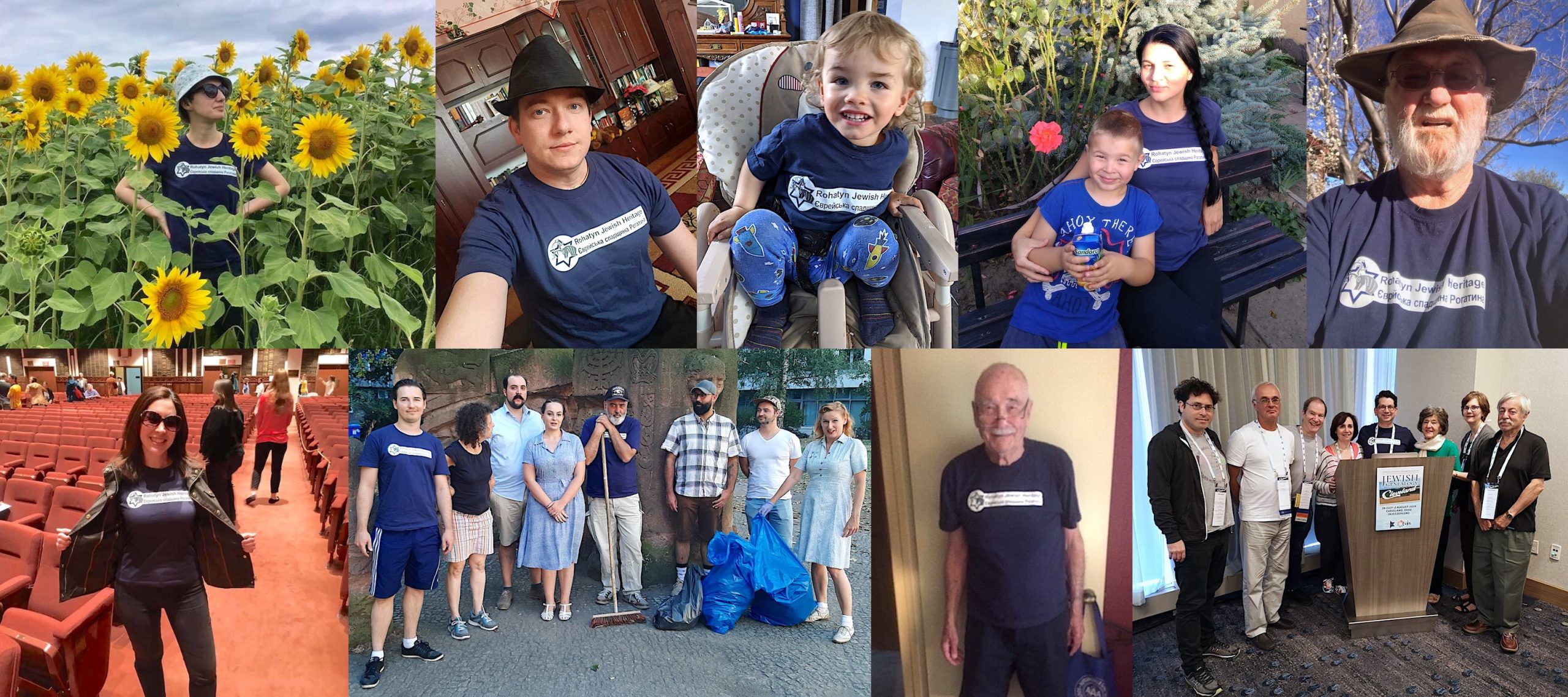This is a descriptive annual report for Rohatyn Jewish Heritage (RJH) covering the calendar year 2020 – in essence a year-in-review summary of our project progress and events, with an outline of our finances as well. To compare our progress in 2020 to our forecast of a year ago, see also our report for 2019. Most elements of this review are hyperlinked to pages with more information, on or off of our website.
![]() Ця сторінка також доступна українською.
Ця сторінка також доступна українською.
THE IMPACT OF THE PANDEMIC

Candles lit remotely around the world in June because no memorial gathering was possible in Rohatyn this year. Images courtesy Rohatyn descendants and friends.
As for nearly everyone in the world, the coronavirus pandemic significantly affected our NGO operations and our lives. Marla and I were compelled to leave our apartment in Lviv and return to California at the end of March. Programs on which we have depended in the past including the US Peace Corps in Ukraine and the Fulbright Program were terminated in March, with all volunteers and scholars sent home to the US. Many of our friends and colleagues in the Lviv area became sick with COVID-19, some quite seriously. Now nine months later we have still not returned, and as of this writing we don’t know when it will be reasonably safe to resume normal work and life in Lviv and Rohatyn – we are frustrated but optimistic. Fortunately we have been able to adapt most of our operations since spring, and with the kind help of Ukrainian friends and colleagues back home in Lviv, Rohatyn, and the region, our work continued even while Marla and I have been physically absent. Our work caring for and maintaining the heritage sites in Rohatyn progressed thanks to the volunteer hands and hearts of these dear friends, as you will see throughout this report, despite the challenges we experienced this unusual year.
JEWISH CEMETERIES CLEARING AND CARE
Seasonal cold weather kept wild grasses and shrubs at Rohatyn’s two Jewish cemeteries from growing significantly until late April this year, after Marla and I had left western Ukraine. In place of the large volunteer clearing events we had organized in past years, beginning in May our good friend and long-time volunteer Vasyl Yuzyshyn began working in the cemeteries using the hand and motor tools our NGO had purchased in 2018 and 2019, each time either on his own or with a small number of Ukrainian friends who had volunteered on our projects previously. From May through September, the new cemetery was fully cleared twice over four days and the old cemetery three times over twelve days. Joining Vasyl in the work three days each were Sasha Nazar – head of the Lviv Volunteer Center (LVC) and a powerful force for Jewish heritage preservation in the city of Lviv and across western Ukraine (Sasha and the LVC have worked with us in Rohatyn six times since 2017, and we have joined Sasha’s large annual international work camps at Jewish sites three years in the past) – and Volodymyr and Yaryna Vasylyk – a hardworking father-and-daughter team from Ivano-Frankivsk who have joined us several times over the past two years, including a multi-day clearing event in August 2019 (Yaryna’s grandmother lives in Rohatyn).
As in past years, cemetery maintenance engaged the most physical work of all of our projects in Rohatyn. In total the volunteers spent 16 long days working at the Jewish cemeteries, either Vasyl alone or with one, two, or three of our other friends. At the end of this year, as the first snows are now dusting the cemeteries, both sites look clean and well-kept, and ready for winter. Vasyl continues to visit and check on all of the burial sites at least once per month even now that the vegetation has stopped growing, to do light cleaning and maintenance and to visibly demonstrate that the sites are all still very much under our care. We will continue to hire Vasyl to make these trips to Rohatyn for us in 2021 as long as we are still away; the pandemic has adversely affected his main livelihood as a professional driver and guide, and we are happy to help him and his family financially in this way. As demonstrated this year, this in turn helps us stay current on any new issues that come up at the Jewish cemeteries or Holocaust mass graves, while also reinforcing our NGO’s continued presence in Rohatyn.
HEADSTONE RECOVERY
As in every year, Jewish headstone fragments surfaced around Rohatyn and we were able to facilitate their return to the old Jewish cemetery. All of the fragments recovered this year were found and reported by local residents, often in response to ongoing work at the cemeteries. Some of the discoveries were reported via the RJH Facebook page or direct Facebook messaging to Marla; others were reported in-person while Vasyl and Sasha were clearing vegetation at the old cemetery. We thank Oleh Yefimovych and Tetiana Petriv for extracting fragments from buildings on their properties and alerting us to their finds, the neighbor who recently bought a house near the old cemetery and found headstone fragments in her side yard, and the local person who brought a pink sandstone Jewish headstone from the 1930s (which had been repurposed years ago as a round grinding stone) and left it anonymously at the old cemetery gate so it could join the hundreds of other recovered headstones. Each of these recoveries rebuilds a collective appreciation of the lost Rohatyn Jewish community, and some like the round stone bring individual names back to living memory. Our thanks are also due to Vasyl and Sasha for providing the muscle to transport the stones and lay them in the cemetery with respect.
MASS GRAVES MEMORIALS
The memorials at the two mass killing and burial sites in Rohatyn were maintained for us this year by a paid arrangement with Ihor Zalypko, an engineer and manager at the vodokanal facility where one of the mass graves is located. In addition to regularly checking on the two sites, Ihor also cleared weeds and planted blooming plants at both sites; regular attention at the sites demonstrates to visitors that the historical events and the victims buried there are not forgotten. We are grateful to Ihor for his courteous and reliable care of the sites, and we will gladly continue the care arrangement in 2021.

Ihor at the north mass grave memorials, and his grounds work at the two south mass grave memorials.
Photos © RJH.
Marla and I visited the south mass grave site with Vasyl in March for a small memorial event before we left Ukraine. Vasyl visited the north mass grave site in June to mark the anniversary of the killings there, and the date was also remembered by Rohatyn Jewish descendants around the world.
Following the detailed design of a project to protect and commemorate the south mass grave site we had commissioned in 2019, this year RJH engaged a friend and experienced Ukrainian Jewish engineer to prepare an alternative design for the site, hopefully at lower cost to improve our ability to cover the costs with donations. The engineer, Hryhoriy Arshynov of Ostroh, had previously surveyed the old Jewish cemetery two different ways for ESJF European Jewish Cemeteries Initiative and had informally advised us on several construction projects. We had exchanged data, preliminary designs, and cost info with Hryhoriy for the south site and were preparing project plans with him in autumn when he reported that he had been very ill with COVID-19, but was out of the hospital and recovering. Tragically, his illness turned worse and he died soon after. Together with the project plans, we have lost a valued friend and colleague, and Marla lost a cousin through her mother’s family roots in Mohyliv-Podilskyi. We mourn his loss; may his soul be bound up in the bond of life…
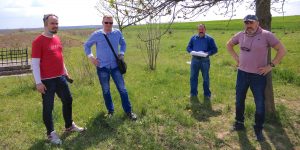
Hryhoriy Arshynov z”l (at right) with his team and with RJH attorney Wito Nadaszkiewicz (at left) at Rohatyn’s south mass grave site in April. Photo © RJH.
In late summer and with the strong support of our NGO attorney Wito Nadaszkiewicz and Ukrainian translator Nataliya Kurishko (both long-time advisers to RJH) as well as our partners the City administration of Rohatyn and Rabbi Kolesnyk of Ivano-Frankivsk, we assembled large and complex project grant applications for memorial construction at each of the two mass grave sites in Rohatyn. To support the application process, the City Council of Rohatyn formally “adopted” the Jewish burial sites in the city as heritage sites under their control and responsibility, which is a very positive step for our work and for the long-term preservation of the sites. The potential grants are part of a new round of German-funded and Ukrainian-managed projects in the Protecting Memory program, now called Memory Network. Our applications are in review now; selected projects will be awarded in the first half of 2021 for implementation between 2021 and 2023 based on urgency and complexity. If we are granted one or two projects, the Ukrainian Center for Holocaust Studies in Kyiv will manage and direct German Foreign Office funds to the research, design, and construction of protection and commemoration features at the site(s), and will work with the City of Rohatyn and its education leaders at the high school and local history museum to develop teaching curricula and other resources to promote a tolerant view of the multicultural past and respect for all heritage sites in the region. We believe competition for these grants must be strong, as the opportunity is unparalleled, but we remain cautiously hopeful that we will be awarded at least one of the proposed projects.
JEWISH BURIAL SITE CARE: BEST PRACTICES AND RESOURCES
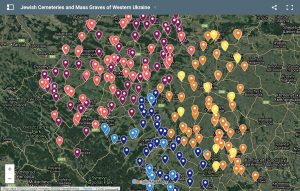
Researched and identified Jewish burial sites in western Ukraine pinned to a Google map. Click the image to launch an interactive version.
As noted, in early spring the pandemic forced a premature end to the worldwide Fulbright program for the 2019-2020 academic year, including Marla’s research project and documentation of resources and best practices for preservation of Jewish cemeteries and mass graves in western Ukraine. However, as we had already done much of the field work and conducted many of the physical surveys, she and I have been able to continue most of her project and build the web publication from afar. Marla reported on our progress in early July, when the project website was first released publicly.
Marla’s Fulbright project supports our heritage efforts in Rohatyn in two key ways. First, the research into and documentation of preservation best practices fills a frustrating void of guidance which we experienced ourselves when first beginning to grapple with Jewish headstone recovery and burial site care challenges in 2011. Now we and others (both Jewish descendants abroad and local Ukrainian civil society activists) can draw on location data, print and digital references, a variety of example projects as case studies, and distilled guidance for planning and managing projects aspects including assessments and surveys, conceptual design, vegetation clearing and landscaping, cleaning and conserving headstones, designing memorials, developing signage, repairing or building perimeter fences, and sustaining sites and projects with funding and communication. Our projects at Rohatyn’s Jewish burial sites and our digital engagement as an NGO have been featured in three of the documented case studies as a resource for others, and we benefit from studying example projects at other sites.
Second, Marla’s original research proposal included development of a detailed project design and plan for Rohatyn’s old Jewish cemetery as a demonstration of the application of the guidance and resources to a multi-featured cemetery project. An update to our earlier project designs and plans was completed and published on our website earlier this year, now including a new proposed memorial incorporating the hundreds of headstone fragments recovered to date with space for several times that number more, plus workable designs for three types of signs and other aspects of the overall project.
We will be unable to complete some components of the full research project until we can return to Ukraine and collaborate with regional experts in stone conservation, landscape design, and construction, but the website is already 85% complete and we continue to make regular progress both in English and in Ukrainian, with the support from our long-time translators.
We consider this an essential part of our work in Rohatyn and the region, because the lessons we and others learn in caring for Jewish burial sites in the region must be advanced locally and internationally to amplify the knowledge and skills of the small numbers of activists to benefit the large number of sites in need, and to reintegrate these sites as shared heritage in their locales. As an example, Marla was contacted in February by two young Ukrainians originally from Putiatyntsi (a village about 4km south of Rohatyn) with information about Jewish headstone fragments found near a cemetery, and during our meeting with them we learned that the village had had an old Jewish cemetery and a Jewish section of a civic cemetery – neither of which was previously known to us or other researchers in the region. We also believe that the cemeteries can be a focal point of heritage education projects in western Ukraine, which was the theme of an online virtual seminar for teachers that we attended over two days in November, organized by Centropa and by ESJF, both organizations with which we have collaborated over the past several years.

Examining Jewish headstone fragments with local people at the cemetery in Putiatyntsi. Photos © RJH.
LOOKING FORWARD: PROJECTS CONTINUING AND IN DEVELOPMENT
In 2021 we expect, of course, to continue caring for the Jewish burial sites in Rohatyn, with friends and colleagues as before once we are able to safely return to the region. We hope that some of this work will also include old and new friends from abroad as well as our long-time supporters in western Ukraine. Headstone recovery work will likely continue as well, unpredictably as always.
In addition to the ongoing “routine” work, we also hope to advance parts of several projects now in development. Our fingers are crossed that RJH and the City of Rohatyn will be awarded Memory Network projects at one or both of the Jewish mass graves in Rohatyn. If we are fortunate to gain an award, it is likely that a significant portion of our time will be needed to support project research, design, and review, but it will be very welcome work for us.
At the old Jewish cemetery, with donations and other funding we hope to finally begin portions of the large project to amplify the commemorative purpose of the site. This would include for example the proposed directional, identification, and information signage, which is already in discussion with Rohatyn City officials and may not require our return to Ukraine to implement. We also intend to review our headstone memorial design details with a landscaping consultant and outline the construction plan for a first trial – the concept intentionally employs components and techniques which can be sourced locally and with basic tools and skills, so that a significant portion of the construction can be done with volunteer labor. Full review and construction will require our presence in Lviv and Rohatyn, so this step must await a strong drop in the severity of the pandemic.
ADMINISTRATION
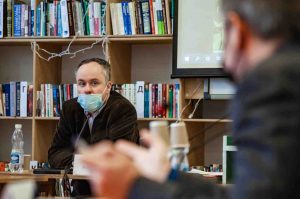
Wito moderating a conference on intercultural dialog and protection of monuments in December. Photo © Shofar Newspaper Lviv.
With much of the world in suspended animation due to the pandemic, Rohatyn Jewish Heritage has been stable and quiet as an organization through the past year. Now for four years as a registered nonprofit entity and still with two employees (Marla and me) and three board members including our long-time friend and advisor Wito Nadaszkiewicz, executive director and managing partner of LawCraft Legal Services and Consulting in Lviv, we have maintained the NGO legally and financially as efficiently as possible from our personal resources. We will of course continue to do so through 2021.
FINANCE
During 2020 and since the founding of the NGO, we have maintained dual-track personal (US) and NGO (UA) bank accounts to stay flexible and reliable in receiving donations and covering project expenses. We aim for transparency by publishing our income and expenses here, as in past years. We also record and acknowledge all donations (more than 50 individual donations in 2020), and every donation (less banking and transfer fees) goes directly to project expenses. Marla and I contribute additional money from our personal savings to cover all administrative, tax, and operational costs, including our own salaries, plus some incidental project expenses. The NGO income and expenses for the calendar year 2020 are listed below in US$ and using a nominal exchange rate of US$1=27UAH to allow for transfer fees and rate fluctuation (through 2020 the rate ranged 23.2UAH to 28.6UAH). Absent the large volunteer events, the summary is much shorter and simpler this year:
Jewish burial sites clearing projects 2020: US+UA bank accounts tools, parts & accessories -$ 277 services: fuel, transport, etc -$ 928 labor exchange donations -$ 1,665 --------------------------------------- total project cost 2020: -$ 2,870 individual donations via GG +$ 2,870 --------------------------------------- end cemetery project balance: +$ 0 (remaining tools and supplies inventory is held by RJH for use in 2021) Other NGO projects & operations: US+UA bank accounts start balance: +$12,167 --------------------------------------- headstone recovery -$ 34 mass graves groundskeeping -$ 400 ground transport Lviv/Rohatyn -$ 872 translations EN->UA -$ 1,210 printing, books, etc -$ 116 project legal services -$ (comp) website domain, hosting, apps -$ 248 banking & wire transfer fees -$ 289 --------------------------------------- net change 2020: -$ 3,169 carryover 2019 expenses debt -$ 1,539 individual donations via GG +$ 6,767 donations from other sources +$ 0 --------------------------------------- end project banking balance: +$14,226 2020 unreimbursed expenses -$ 0 --------------------------------------- net end project balance: +$14,226 [balance = +$7573 US, +$6653 UA, -$0 debt] NGO administration, salaries, etc.: UA bank account start balance: +$ 76 --------------------------------------- permit and gov't fees -$ 934 accounting and bank fees -$ 1,032 salaries+benefits+taxes -$ 4,555 --------------------------------------- net change 2020: -$ 6,445 Osborn personal contribution +$10,521 --------------------------------------- end admin balance: +$ 4,076
As usual, this summary may require updating after the first of the year to include late-year donations or expenses, and a final reckoning by our accountant.
Even in this socially-distanced year there has been a significant positive impact of volunteers on our operations, a contribution which is counted in our sincere gratitude but which does not appear in the tally above. This year the onsite volunteers were all Ukrainian friends whom we miss terribly (named above); we look forward to joining them again for work and laughter in 2021. As always, volunteers from all over the world also contributed remotely to our cultural work this year with generous interpretations of headstones and archival files and other technical and language assistance. The advice and help comes from too many people to name, but this year we particularly want to thank Alex Feller and the Rohatyn District Research Group (RDRG), Christian Herrmann, Gerald Pragier, and especially Hryhoriy Arshynov z”l and Michał Piasek. Finally, as in every year, we wish to publicly recognize Wito Nadaszkiewicz and LawCraft Legal Services and Consulting in Lviv for continuing to donate time and expertise to our NGO in the form of discounted legal service and pro bono support.
Speaking of finance, we gratefully thank Gesher Galicia for its volunteer contributions, and in particular their PayPal Administrator and Operations Manager Shelley Kellerman Pollero, CFO/Treasurer Charlie Katz, and President Steven Turner, for making the donations process to Rohatyn Jewish Heritage tax-deductible for US taxpayers and simple for everyone.
As always, Marla and I continue to volunteer our own time throughout the year to support project work and administration of the NGO, even remotely now until we can return to Ukraine. We aim to continue while we remain healthy; this work is our passion.
THANK YOU TO OUR SUPPORTERS
This year was unusual in many ways. One aspect which did not change, however, was the generous, hard-working support given to us by Vasyl Yuzyshyn, and this year he practically carried Rohatyn Jewish Heritage on his back. Including visiting 6 times with Marla and me in winter, Vasyl traveled to Rohatyn 28 times throughout 2020, at least once every month (and 5 times in May!). Vasyl is as recognized in Rohatyn as we are, and that’s a great benefit to us: when local people have questions or information, they know who to speak with. Vasyl was even mentioned with a photograph in a May news article in the regional newspaper “Holos Opillya” (Voice of Opillya) about the work our volunteers were doing in the Jewish cemeteries during the pandemic. This year as in past years Vasyl not only transported us and other volunteers to Rohatyn, and joined in the vegetation clearing, he also served as our interpreter and informal ambassador, managed payments for materials and labor, collected and moved headstone fragments to the old cemetery, marked historical events on their anniversaries, welded and repaired cemetery fencing, delivered items on our behalf, and served as a contact point for us in a variety of tasks, always with his warm smile and courteous demeanor. We are very fortunate to have this valuable friend by our side, both physically and virtually.
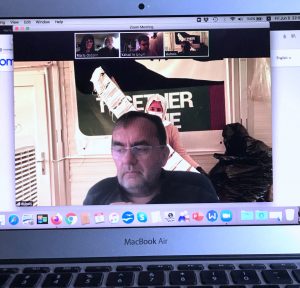
A Zoom conference with the leadership of Yahad – In Unum
(who were also displaced by the pandemic) in June. Photo © RJH.
Essential support comes every year from our NGO partners, and this year we were helped again by the City of Rohatyn, which contributed significantly to the mass graves project grant application and related legal and documentation work. Data and advice about regional cemeteries and mass graves identification and care was provided again by our friends at ESJF European Jewish Cemeteries Initiative and at Yahad – In Unum; our connection with Yahad goes back to 2009, and includes joint work in the transcription of Yahad interviews with Ukrainian witnesses to the Holocaust in Rohatyn. Continuing a decade of close collaboration, the Rohatyn District Research Group (RDRG) again contributed data, historical records information, suggestions, and advice; the RDRG plays a key role in our cultural bridge-building.
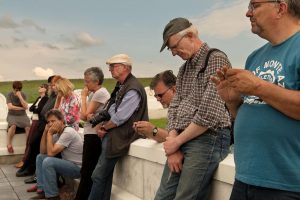
Some of the German travelers listening to a reading near the south mass grave in Rohatyn. Photo CC-BY-NC-ND Christian Herrmann.
Finally, we would like to acknowledge the many individual donors who provided funding this year to sustain our work in Rohatyn. More than fifty personal donations were received, several from friends who donated more than once this year, and including a few quite substantial donations. We are pleased and proud to list this year’s and past donors on our website, and note that some donors also gave anonymously. Among those who have given repeatedly over the years, we would like this year to acknowledge an informal group of German travelers who were led through Jewish heritage sites in western Ukraine and Moldova by our longtime friend and colleague Christian Herrmann in 2018, including a stop in Rohatyn; this group, with whom we enjoyed a dinner before the start of their journey, continues to engage with the people and places they encountered, and have repeatedly contacted us to provide support.
Our absence from Lviv and Rohatyn for much of the year meant many fewer opportunities to meet in person with people, to share work and ideas, but we are still happy and amused to share a handful of images of friends and colleagues wearing our branded t-shirts this year. It’s just one of the many ways we can spread our message and the connection between Rohatyn and the world. We very much look forward to an even stronger connection next year.

